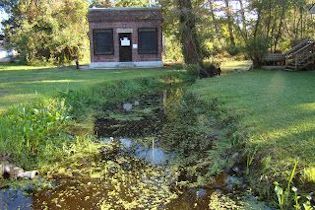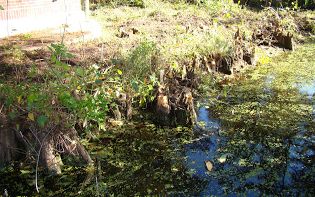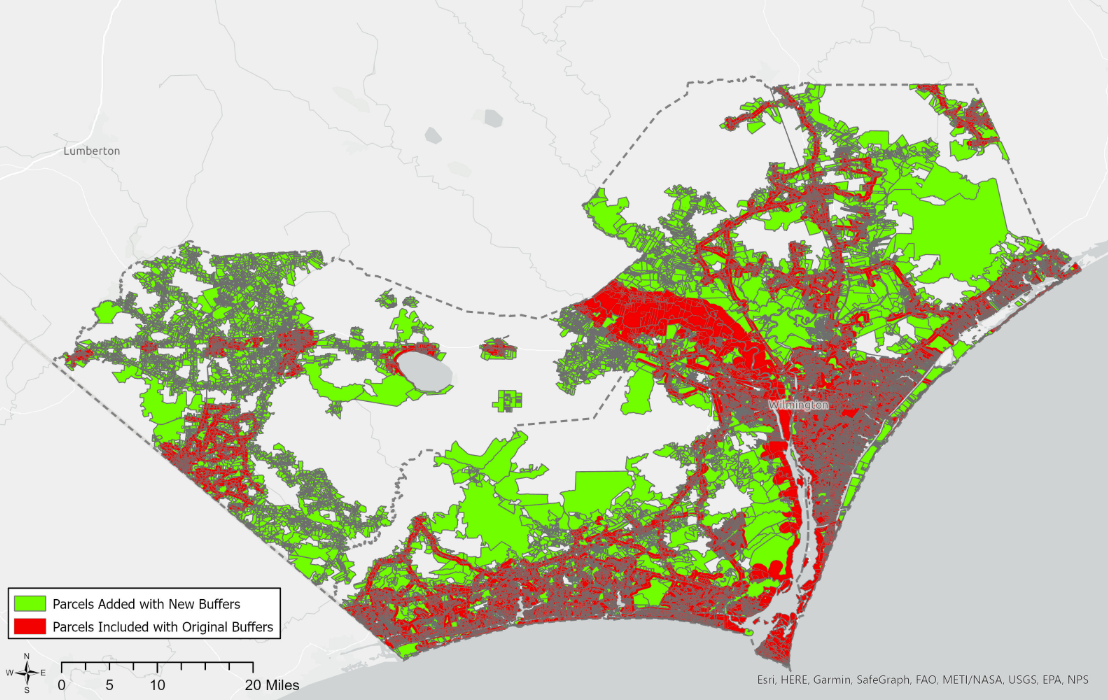ELIZABETH CITY — Tommy Perkins sat on his back deck earlier this month, watching as a backhoe arrived on the city property across the small creek running behind his house. He figured the crew was sent there as part of a city-wide effort to clear its waterways.
But he was shocked to see the gaping jaws of the machine start ripping out the bald cypress knees lining the creek.
Supporter Spotlight
Perkins ran over to the operator, shouting, “Why are you doing this? Please stop!”
 The “ditch” behind Tommy Perkins’ house. Photo: Tommy Perkins |
 The bulldozer cleared some of these cypress knees. Photo: Tommy Perkins |
He then called the mayor and started filming the operator as he continued clearing the area. He later blogged about it online. Since it was late in the day, the backhoe soon stopped, he said, but not before damaging about eight cypress knees.
“What was absolutely beautiful is now absolutely ugly,” Perkins said in a telephone interview.
It’s not just the besmirching of his view that concerned him. Destruction of the cypress knees, he said, would negatively impact the ecosystem of the tributary that drains into Charles Creek, which drains to the Pasquotank River.
Perkins, 63, grew up in Elizabeth City and has lived at his current home off Dawson Street for six years.
Supporter Spotlight
Cypress knees, which look similar to ancient tree stumps poking out of the water, are the extension of the root system of cypress trees that typically grow in swampy land.
But staff with the state Division of Coastal Management said the area behind Perkins’ house is not protected by their rules.
“It is a ditch that is in the middle of Elizabeth City,” said Frank Jennings, a district manager for the division. “From what we see, the city is doing its routine maintenance.”
After Perkins contacted him, Jennings sent Lynn Mathis, a division environmental specialist to assess the situation. “Jurisdiction along the tributary/ditch in question ends at Dawson Street where navigability ends,” Mathis said in an Oct. 22 email to Perkins. “Therefore, the area of disturbance in question does not fall within the shoreline of a jurisdictional waterbody.”
Even so, Mathis also informed Perkins that “the cutting of non-coastal wetland vegetation along the ditch” would not violate division rules.
Richard Olson, Elizabeth City manager, in an interview described the creek as a “drainage ditch” that is only accessible off Dawson Street. As one of the city’s “historic drainage areas,” he said, there are no drainage easements associated with it.
 Rich Olson |
The city has spent several months, on and off, doing “improvements” in that ditch to remove flow obstacles. And Olson said it is not a designated “blue line” ditch that requires a CAMA permit.
“We have vegetation issues, downed tree issues,” he said.
Olson, who was contacted about Perkins’ concern by Mayor Joseph Peel, conceded that several cypress knees were damaged by the city backhoe, but “nothing significant” enough to cause harm to the one cypress tree he is aware of in the area.
The city plans to do additional clearing work in the creek, he added.
There is no scientific consensus on the physiological role cypress knees play for cypress trees, said Sam Pearsall, senior scientist with the Environmental Defense Fund.
Most likely, he said, the knees help oxygenate the root system. They also help with the sedimentation process by slowing the movement of water, similar to what mangrove trees do in the tropics.
As the cypress trees get older, he said, they make more knees and the existing knees tend to grow. A young tree may have no knees; an ancient one growing unimpeded in a swamp could have hundreds of knees.
“Tearing up the knees would unquestionably injure the tree,” Pearsall said. “It injures the tree badly.”
Depending on the amount of damage to the root system, he said, the cypress tree associated with the injured knees could die a slow death by insect damage, infection or starvation. Or it could be weakened to the point where it would be blown over in a storm.
Pearsall said that in his opinion, the presence of cypress knees in the waterway, whatever it is called, is enough reason to not permit dredging.
“If it’s a ditch and it has cypress trees growing in it,” he said, “it’s a wetland.”
Perkins, a former Coast Guardsman and retired pilot who most recently worked for military contractor Blackwater, said that the tree the knees support is huge and just feet from his house.
Perkins said he enjoys sitting on his deck watching the mallards gliding among the cypress knees in the creek.
“To rip those cypress knees up, it was crude and it was unnecessary and it was ugly,” he said. “If they want to call it a ditch, it doesn’t make these cypress knees any less important or any less beautiful.”







